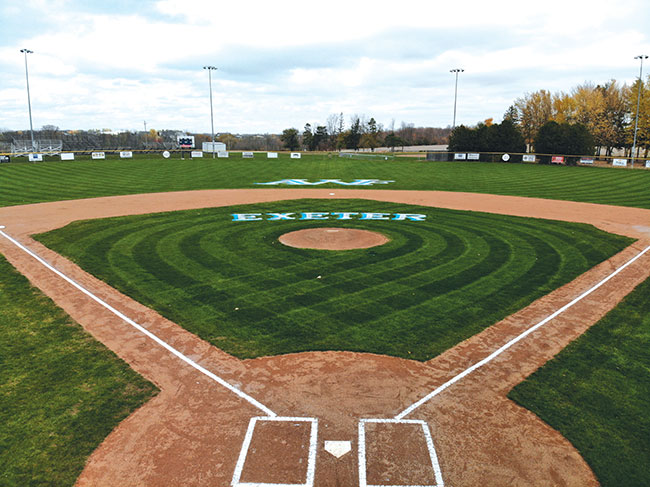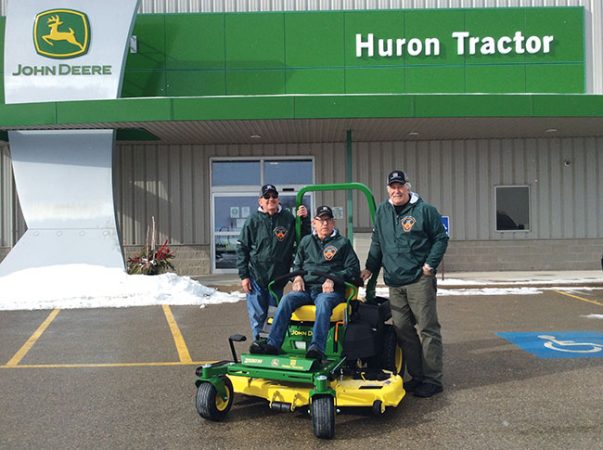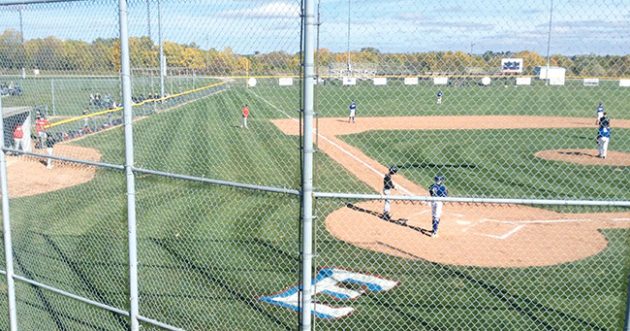
Features
Sports turf
Small town baseball field has big city appeal with its attention to detail and maintenance upkeep
Exeter, Ont.’s Alvin Willert Field holds its own with some of Canada’s top diamonds
March 8, 2022 By Mike Jiggens
 Photo credit: Brad Gregus
Photo credit: Brad Gregus Exeter, Ont. boasts the province’s first baseball field to implement an innovative – for the late 1980s – red clay-based product on its skinned infield areas. Known as Mar-Co Clay, the product is a combination of processed raw red clay, fired red clay and angular sand. The material, which replaced an original limestone screening product, caught the attention of neighbouring municipalities for its better performance, and several other ball diamonds in the area incorporated the new product soon afterwards.
Today, approximately 95 per cent of baseball fields and 70 per cent of softball fields in Ontario are being played on Mar-Co Clay.
Exeter’s Alvin Willert Field is celebrating its 40th anniversary this year, and continues to use the product on its skinned infield areas.
The field’s architect and builder, Brad Gregus, recalled his disappointment with the original limestone screenings – often referred to as stone dust – that was used on the diamond’s basepaths and skin area.
“After two or three years of that, I became frustrated, realizing that it wasn’t performing the way I wanted it to, but there was nothing else available,” he said.
Gregus criticized the screenings’ “fines,” or the fine dust portion of the mix, which he compared to portland cement. He said the dust typically settled between three-quarters of an inch to an inch into the composition and would lock up vertical drainage flow during a rain event, causing the material on top to become mushy and unplayable. Large, shallow ponds would consequently form in the skinned areas.
After playing baseball himself in Stratford, Ont. in the 1970s, Gregus dreamt of building a “real” baseball field in his hometown, complete with a grass infield, dugouts and perimeter fencing. At the time, the southwestern Ontario town had one other baseball field as well as a single softball field. The existing baseball diamond, however, featured a fully skinned, stone dust-covered infield.
With the support of local service clubs, Gregus succeeded in getting the municipality to approve the construction of a new field and one that could potentially become a draw for elite play and tournaments. The construction site was prepared in 1980 with an emphasis on proper drainage, and the field was constructed the following year. It opened for play in June of 1982.
Gregus was employed by EllisDon Construction at the time of the field’s construction and met by happenstance Ron Martin, a fourth-generation manufacturer of brick and clay tile, whose operation was in Wallenstein, Ont. With Martin’s in-depth knowledge of clay in both the fired and raw forms, and Gregus’ expertise in baseball field construction and performance, they collaborated their efforts to develop a product that contributed to better-performing infields.
Learning it was the limestone dust that was responsible for the ponding following a rain event, their new red clay product was developed and perfected at a makeshift lab inside Gregus’ garage, and the duo founded Mar-Co Clay Products.
Soon afterward, Martin solicited the help of the University of Guelph to develop the lab at the company’s manufacturing facility to access materials more accurately and provide custom solutions.
“Ron wanted to ensure we were making the very best product possible.”
As the business grew, Gregus took a leave of absence from EllisDon from 2009 to 2013 to set up Mar-Co Clay manufacturing facilities and grow the network of dealers and distributors in the United States. He said the experience helped nurture his knowledge of turfgrass since his dealers were all graduate agronomists who sold seed, fertilizer and pesticide products for the turf industry.
The Mar-Co Clay product is currently used by baseball and softball fields throughout Canada and the eastern United States on skinned infields, pitcher’s mound and home plates areas, and on warning tracks. The company’s mound and home plate products are also shipped to the Caribbean, Japan and Korea. The red clay composition is noted for its ability to enable faster vertical drainage through the material, increase absorbency within it, as well as retain moisture longer during dry periods.
Return of grass infield
Gregus’ desire for a grass infield at Alvin Willert Field almost failed to materialize. When he presented his drawings to the town more than 40 years ago, its engineers redid the plans with an entirely skinned infield in mind. The change back to Gregus’ original vision occurred as Exeter’s recreation director was about to retire, and “no one was watching the fort” between the time of his retirement and the hiring of a successor. A last-minute decision during the construction period was made to replace the last six inches of gravel and limestone in the infield with a topsoil-sand blend, leaving no one aware of the plan until seed establishment was realized.
“My original intent and plan was to put a grass infield in,” Gregus said. “The town decided to go with a fully skinned infield. But, at the last minute, I pulled the trigger on the infield change.”
The town opted to stick with the already grown-in grass infield – a decision Gregus described as a “coup” – and the stone dust skin and basepath areas eventually gave way to Mar-Co’s red clay product in 1990.
The field, named for a long-serving recreation director, measures 311 feet in left field, 342 feet in left centre, 382 feet in centre field, 352 feet in right centre and 318 feet in right field. Its turf is a combination of Kentucky bluegrass, fescue and ryegrass.
“I’m slowly introducing more fescue and rye to it,” Gregus said, noting the strategy lends itself to better resilience in the outfield to drier weather. Although plans are in store to irrigate the outfield as well, only the infield and foul areas outside the basepaths and behind home plate are currently irrigated. The introduction of more fescue and ryegrass in the outfield is meant to help until the field is fully irrigated.
“Bluegrass doesn’t perform quite as well because it’s a shallower root.”
The current irrigation system was installed in the mid-1990s. About a decade later, four more heads were added outside of the skin to deliver water over a 30-foot margin onto the outfield and skinned infield areas.
Gregus said the field suffered from severe drought in its early years, prompting the irrigation system’s installation.
“An irrigated field will perform much better,” he said. “Healthy turf is safer, performs better, and is easier to take care of, and allows for better athletic performance.”
Gregus has reached out to local agronomists with turf seed expertise, saying their help is “invaluable.”
Now retired from both EllisDon and Mar-Co Clay Products, he continues to devote his time to taking care of the field along with fellow retiree Doug Fairbairn, who oversees infield and foul area cutting as well as field scheduling with all teams, serving as the liaison with the municipal parks department. Charlie Beausoleil, a retired millwright/welder and machinist, maintains the equipment and builds specialized equipment pieces.
Strict attention is given to field maintenance so that the diamond delivers the ultimate in playability.

Three of the key individuals responsible for the upkeep of Alvin Willert Field, from left, are Doug Fairbairn, field scheduling manager; Charlie Beausoleil, equipment manager; and Brad Gregus, groundskeeper. Photo credit: Brad Gregus
Mowing practices
The infield is mowed at 1-3/8 inches while the outfield is cut at a height of 1-7/8 inches. During the 2021 season, the field was mowed 66 times. Blades are sharpened before each mowing session to ensure the turf plants heal quickly, retain moisture and promote uninterrupted growth. Rollers are attached behind the mowers, mainly for striping reasons, but serve another important purpose. “What we found is it’s actually quite good in pressing down and taking care of the small bumps and minor damage caused by athletic play. You’re gradually making a flatter surface.”
Most “bumps” appear in the spring because of frost coming out of the ground and lifting root systems.
Local John Deere dealer, Huron Tractor, loans out a zero-turn mower to cut the outfield. The arrangement has proven to be a big boost to the team’s efforts, resulting in better turf conditions.
The best time to prepare for each new season is in the fall, Gregus said, noting it’s the ideal time to put down ample potash and slow-release phosphorus. Phosphorus is applied in November or December and is good through May or June, he said. Potash produces food for the root system during the winter months while phosphorus helps expand the root system both horizontally and deeper into the ground.
The fall is also when the infield and basepaths are worked up a full 1½ inches and everything is edged. The goal is to have the field ready for play by March 31.
“Depending on when snow disappears, we’re ready to play in 10 days after snow is gone because the field is so well drained. The town did an excellent job of getting it drained before we built it.”
The town had put in a gravel base to within six inches of the finished level in anticipation of creating a fully skinned infield at the time of the field’s construction. Another three inches of gravel and three inches limestone screenings were slated for inclusion, but the last-minute decision to grow in a grass infield saw six inches of topsoil added instead to the base gravel layer.
“Because of that, it drains really well. We can have a six-inch rain and it goes straight down. We have no rainouts on this field.”
The field was constructed on what was previously a heavy clay base, with an 18-inch layer dug out, and replaced with granular ‘A’ gravel and drained every 16 feet. Gregus said it was essentially a farm drainage project using six-inch “Big O” headers and four-inch “Big O” common runs. The high end is along the first baseline and out-of-play area by the first base dugout, with everything draining toward left field.
Field preparations for the next game are made immediately following the previous contest with much of the work accomplished by the players and coaches. Once a game or practice has ended, six players are assigned three-foot and six-foot rakes for the basepaths and skin area, while five other players use stiff stable brooms to work on the field’s grass/dirt edges. Each player is responsible for about 175 lineal feet which they’re able to groom in about six minutes. Five players will sweep while six others rake the skinned basepaths. Additionally, a pitcher will work with a coach to rebuild the mound while a catcher joins another coach to build back the home plate area.
Gregus oversees this post-game and post-practice ritual, then personally tends to watering and tarping.
“We take a lot of pride in our edges. Every time we practise or play out there, the edges are swept with the stiff stable brooms. I’m adamant about that. That’s almost the most important practice on the field.”
In addition to this day-to-day regimen, Gregus also uses a power broom sweeper six times a year, followed by edging with a Turfco edger and “down on your knees” trowelling of the edges to “exact flatness.”
He points out, “I prepare for every game as though it’s the Yankees coming in to play the Dodgers.”

Game play at Alvin Willert Field. Following the game, players will exchange their bats and gloves for brooms and rakes to tend to the skinned areas. Photo credit: Brad Gregus
The need for good edging
The goal behind good edging is to have the baseball retain a consistent trajectory, whether a hard-hit ball bounces two inches on the grass in front of the edge, directly on the grass/dirt edge or two inches beyond the grass/dirt edge, he said. The practice allows infielders to attack the ball and be confident a bad hop won’t strike them in the face. If a player’s feet can’t detect a lip-free, grass-to-dirt interface, the maintenance was performed correctly.
Gregus supervises the work and ensures the infield material is tamped down hard, soaked thoroughly and covered with tarps overnight.
“The best time to prep an infield, mound and home plate area for a game is immediately following a game. In other words, at night, post-game or post-practice when we work these areas, watering them down and packing down the clay, making them game-ready. This is followed with a liberal soaking of the areas and then tarping them until mid-afternoon the following day. This process allows for the clay to dehydrate very slowly, resulting in optimum firmness for the following game or practice.”
Leaving tarps in place for as long as possible allows the clay to get tight and firm so that it won’t pulverize as easily.
If tarps don’t cover the skinned areas, and it’s windy and sunny the following morning, water will dehydrate quicker, creating fissure cracks. By game time, the material will pulverize faster than if it’s kept damp for as long as possible.
Weeds are kept at bay by maintaining a strong turf root system. Gregus uses an aggressive fertilizer program of nitrogen, liquid iron and phosphorus to “squeeze out” weeds.
Alvin Willert Field is part of a sports field complex that includes three other diamonds and soccer fields. The town looks after all maintenance required at the other fields and had previously mowed Willert Field. As Gregus and Fairbairn neared retirement and had more time available, they assumed the mowing duties themselves as well as the remaining upkeep inside the fences. Gregus said he still considers the town as “an integral partner in the overall package” because it provided such critical infrastructure as lighting, fencing, the backstop and bleachers, and is helping plan future improvements.
Lights were installed at the field 20 years ago, allowing for night play.
The field is used by the town’s minor baseball leagues, elite teams and a senior team that has captured the Ontario Senior AA championship four of the past seven seasons. Prior to the COVID-19 pandemic, the field saw game play five or six times a week. Including practice time, it was used every day. Use of the field was restricted to elite teams in 2020 in compliance with COVID protocols, and local and elite teams played shortened seasons in 2021.
Even though field usage was limited the past two seasons in comparison to pre-pandemic years, maintenance practices were perhaps a little greater, Gregus said, noting grass and weeds aren’t aware of COVID and the shutdown of most games.
Various groundskeeping duties are performed annually from late March to December. The field’s final cut in 2021 was made on Dec. 12.
His plans for 2022 include continued improvements and the extension of the existing irrigation system. Additionally, the production of a six-step YouTube video is planned, to demonstrate how to properly edge and maintain a ball field’s grass-dirt edges.
Gregus says he is indebted to the late Mike Reagan of Labatt Park in London, Roger Bossard of the Chicago White Sox and Dave Mellor of the Boston Red Sox.
“These guys would give me all afternoon if I wanted, showing me their techniques and answering every question with genuine interest. They’re great teachers and have been great mentors to me.”
Gregus added he is committed to “helping young guys develop skills and confidence in improving and maintaining their fields.”
Print this page